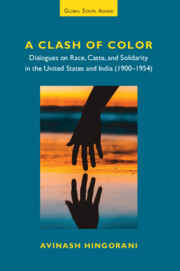 A Clash of Color
A Clash of Color Book contents
- Frontmatter
- Dedication
- Contents
- Acknowledgments
- Prologue
- Introduction
- 1 Rabindranath Tagore in America: Ideas and Impact
- 2 Lala Har Dayal, Taraknath Das, and the Ghadar Party
- 3 Lala Lajpat Rai and W. E. B. Du Bois
- 4 Lala Lajpat Rai in India
- 5 W. E. B. Du Bois and the Indian Independence Movement
- 6 W. E. B. Du Bois, Walter White, and B. R. Ambedkar’s Quest to Address Race, Caste, and Class
- Epilogue
- Bibliography
- Index
6 - W. E. B. Du Bois, Walter White, and B. R. Ambedkar’s Quest to Address Race, Caste, and Class
Published online by Cambridge University Press: 28 November 2024
- Frontmatter
- Dedication
- Contents
- Acknowledgments
- Prologue
- Introduction
- 1 Rabindranath Tagore in America: Ideas and Impact
- 2 Lala Har Dayal, Taraknath Das, and the Ghadar Party
- 3 Lala Lajpat Rai and W. E. B. Du Bois
- 4 Lala Lajpat Rai in India
- 5 W. E. B. Du Bois and the Indian Independence Movement
- 6 W. E. B. Du Bois, Walter White, and B. R. Ambedkar’s Quest to Address Race, Caste, and Class
- Epilogue
- Bibliography
- Index
Summary
India finally achieved independence in 1947. Afterwards, W. E.B. Du Bois sought to utilize the newly free country to put pressure on the US to address its racism. His strategy was to build publicity and awareness of White supremacy in the US amongst the international community. His primary means for doing so was by drafting a petition for the United Nations (UN) in collaboration with the National Association for the Advancement of Colored Peoples (NAACP), hoping that the UN could mandate a resolution for Black civil rights. Du Bois's efforts caught the attention of B. R. Ambedkar who saw parallels between the Black American struggle and Indian untouchability. Using Du Bois as a source of inspiration, Ambedkar sought to create his own UN petition to solve India's caste problem. Du Bois's petition did not reach the floor of the UN, however. Prominent NAACP members such as Eleanor Roosevelt refused to present it, fearing that it could tarnish the international reputation of the US. Ambedkar also did not follow through on his UN petition and instead tried to address caste by working with the Nehru government.
One of the most significant aspects of Du Bois's work during the 1950s was his generation and harnessing of negative Indian sentiment toward the US to apply pressure upon the US government to address Black civil rights. In 1951, Du Bois collaborated with fellow Black Americans Paul Robeson and William Patterson to draft a second UN petition. While the petition again stopped short of the floor of the UN, it tarnished America's image amongst some Indians and the Indian media and increased Indian awareness of American racism. As a result, it prompted Supreme Court Justice William O. Douglas to urgently repair the image of the US abroad. Indian public opinion played a part in pressuring the US Supreme Court to desegregate public schools through the 1954 Brown v. Board of Education decision. Douglas along with fellow justice Earl Warren acknowledged it as an influential factor, although international concerns were not cited explicitly in the ruling's text.
- Type
- Chapter
- Information
- A Clash of ColorDialogues on Race, Caste, and Solidarity in the United States and India (1900–1954), pp. 126 - 148Publisher: Cambridge University PressPrint publication year: 2025
